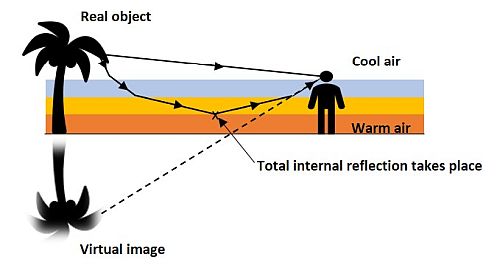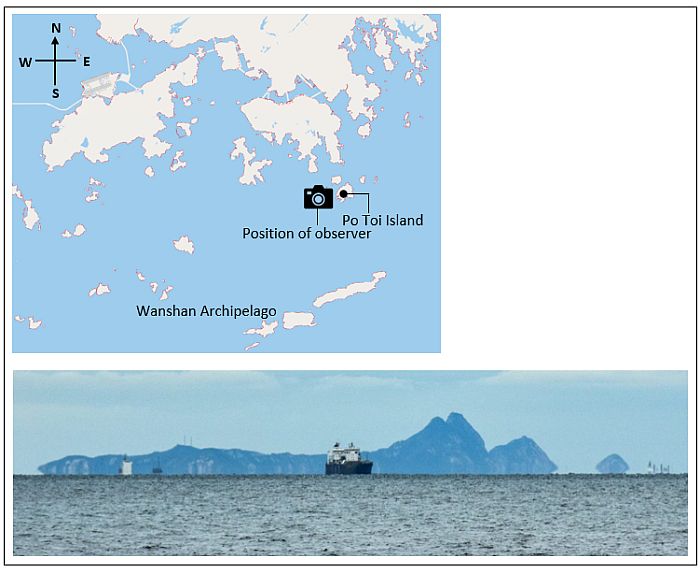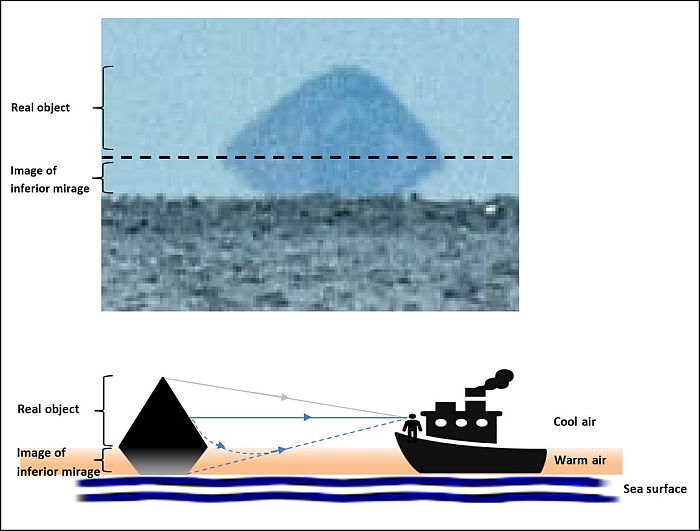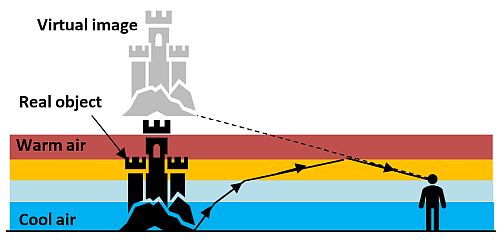Mirage
25 May 2020
LEUNG Lai-lai PAN Chi-kin LEE Tsz-cheungWhen we drive along a hot road on a sunny day, the place at a distance may appear to be suspiciously covered with a pond of water. The ground is dry and the water that appears on the road is in fact an inverted image of the sky above the hot ground surface. This phenomenon is called a mirage.
Some people believe that mirages are caused by imaginations. It is actually a natural optical phenomenon. To understand how a mirage forms, we first need to understand how light travels through air. Normally, light travels in straight lines. However, when it passes from one medium to another (e.g. air, water and glasses, etc), it will bend or change its direction due to the difference in optical densities between the media and such bending is called refraction. There are many daily life examples of refraction, such as chopsticks appearing bent when partially dipped in water.
Generally speaking, when light passes the boundary between two media, part of the light will be refracted while the remaining part will be reflected at the interface. If the angle of incidence exceeding a certain value, no refraction will take place and all light will be reflected as shown in Figure 1. The complete reflection of light at the interface is called total internal reflection.
If the temperature within an air layer is uniform, light will travel through it in a straight line. Sometimes, air temperature varies with height. In this case, light will travel through more like in a curve, such as that in Figure 2. Under suitable conditions, total internal reflection may even occur to produce a displaced image of distant objects. The displaced image is called a virtual image.

Figure 1 When the angle of incidence θ increases, refracted ray becomes dimmer while reflected ray becomes brighter.
If the angle of incidence exceeds a certain value, all light will be reflected.
According to the position of the virtual image relative to the original object, mirages can be classified into two main categories, namely inferior mirage and superior mirage.
Inferior mirage

Figure 2
For inferior mirage, the image of the original object is displaced downwards. Inferior mirage usually occurs when warm air lies beneath cold air. As illustrated in Figure 2, when light rays from distant objects travel from a dense layer of cold air (above the line of sight) to a layer of less dense warm air over a hot ground (below the line of sight), the light ray from the above will be continuously refracted and gradually become totally reflected, causing the light rays curving upwards. An inferior mirage is inverted because light rays from the object enter the eyes of the observer from below the horizon. Hot road or desert surface generally favours inferior mirages to occur because air closer to the ground is significantly warmer than the air above it.Inferior mirages are most commonly seen over land but sometimes it can also be observed over sea. With a cold front moving across the coast of Guangdong in the night of 15 February 2020, local weather became appreciably colder the next day. The temperatures over the territory in the morning of 16 February were generally around 14 to 16 degrees Celsius, which were seven to eight degrees lower than those of preceding day. Unlike air, the temperature of sea water dropped much slower, resulting in warmer temperature than that of the air above. In fact, the sea surface temperature at North Point was 19 degrees Celsius in the morning of 16 February, much higher than that of the air above. At around noon on the same day, a passenger onboard a ferry near Po Toi Island observed an inverted image of the sky and bottom parts of an island from afar (Figure 3). It was likely attributed to a thin layer of warmer air in contact with the sea surface at the time and the refraction of the light rays from the distant objects (Figure 4).

Figure 3 An inferior mirage occurred in Hong Kong on 16 February 2020. Photo was taken by Conson Leung
who was onboard a ferry looking in the southwest direction towards Po Toi Island.

Figure 4 A layer of warm air in contact with the warmer sea surface refracted light from a distant object
leading to the occurrence of inferior mirage.
Superior mirage

Figure 5
Contrary to inferior mirage, superior mirage appears as an image riding on the actual object and this often happens when the air layer aloft is warmer than that near the ground, an opposite condition of the inferior mirage (Figure 5). While air temperature usually decreases with height, sometimes the reverse is true. For example, when a warm air mass moves over the cold sea or ice surface, the lower layer of the air mass will be cooled down by the ice or cold sea surface. This will result in a so-called temperature inversion with the bottom layer of air colder than the layer above. A superior image can be inverted or erect, depending on the object distance and the temperature differences between air layers.

Figure 6
If the bending curvature of light rays is about the same as the curvature of the Earth surface, the object which is below the geometric horizon will appear to be displaced and become visible above the horizon (Figure 6).
Sailors at sea sometimes claim to see strange things above horizon like floating castles and flying boats. Many of these sightings were actually the result of optical phenomena. Apart from the two kinds of abovementioned mirages, there are also other kinds of mirages like lateral mirages and Fata Morgana. We can talk about them next time.
(Diagrams in this article are not drawn to scale.)
Reference:
"Cool Met Stuff" : Mirage